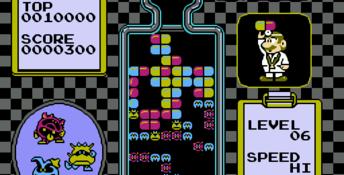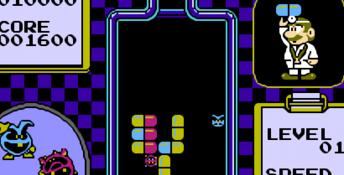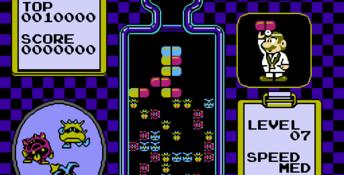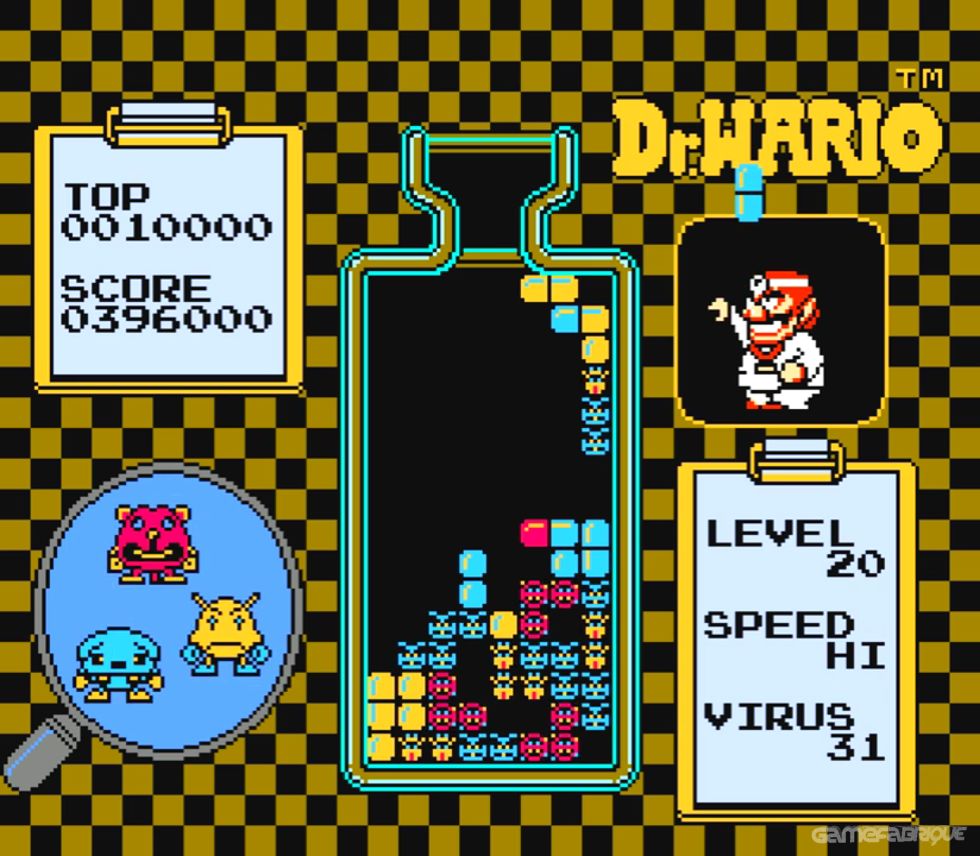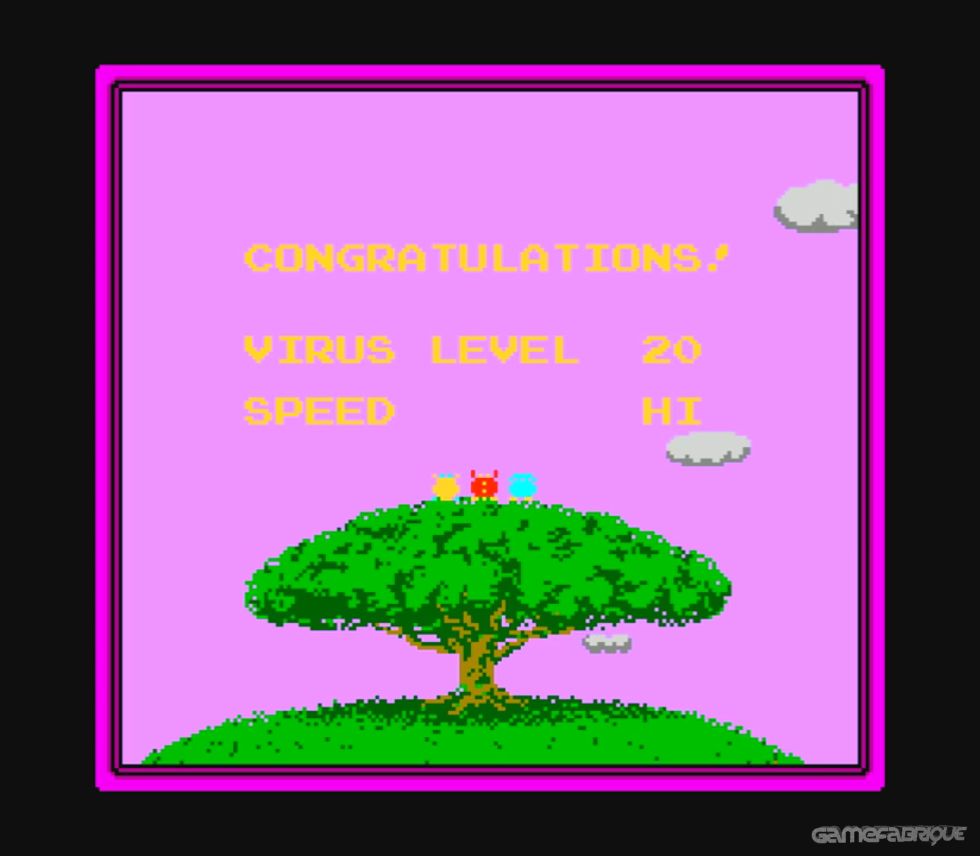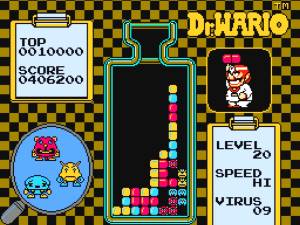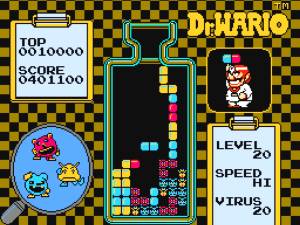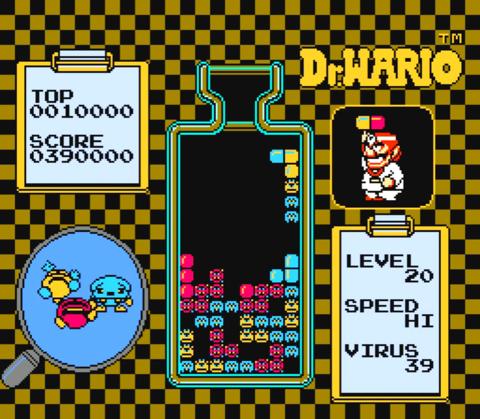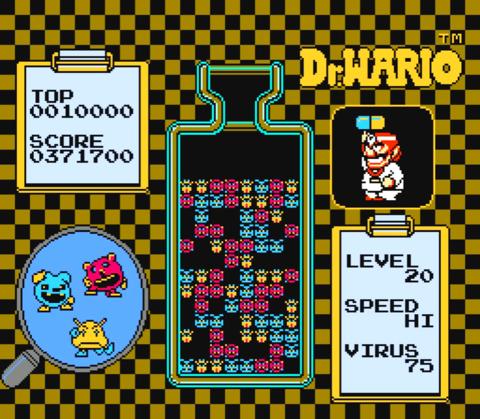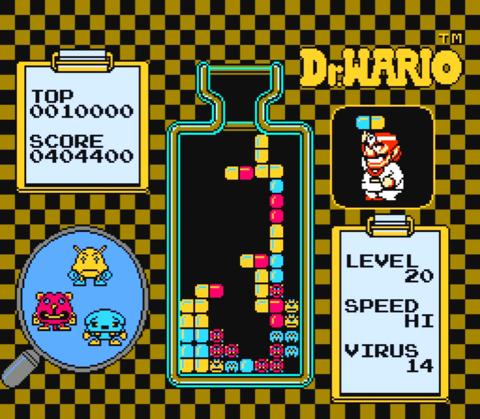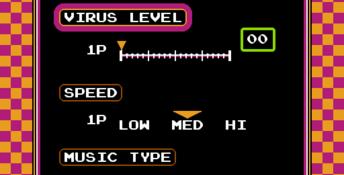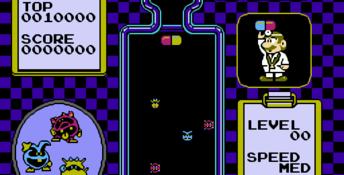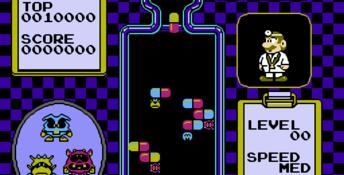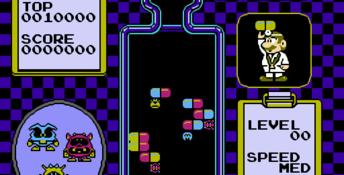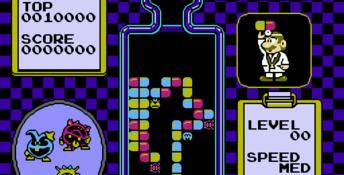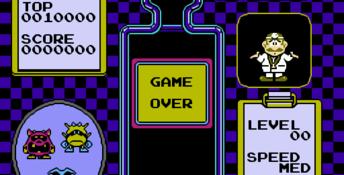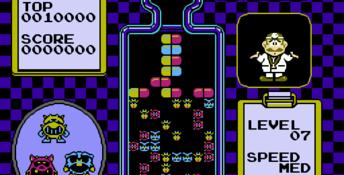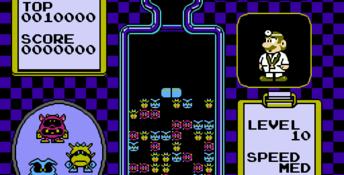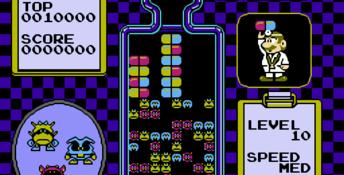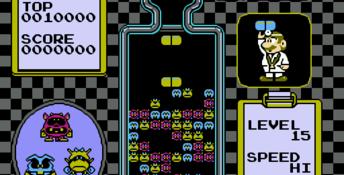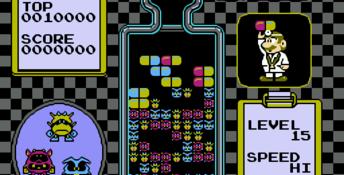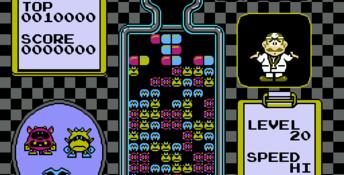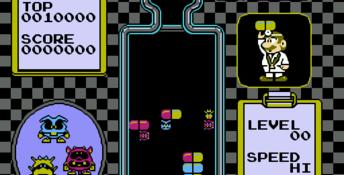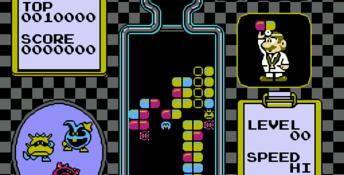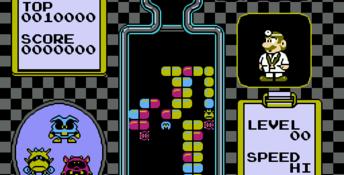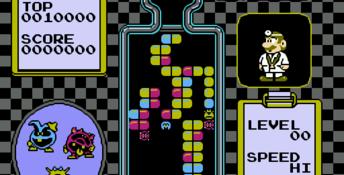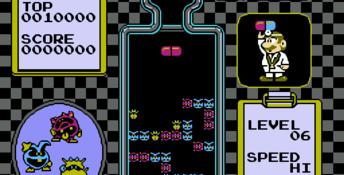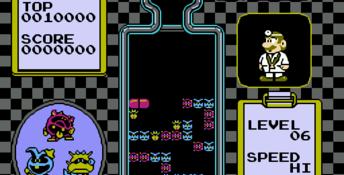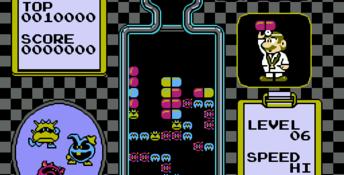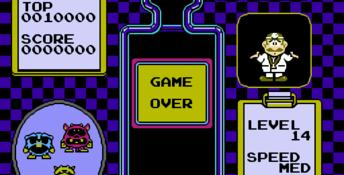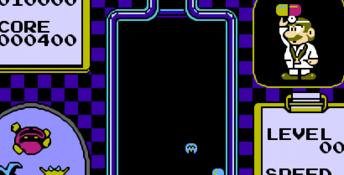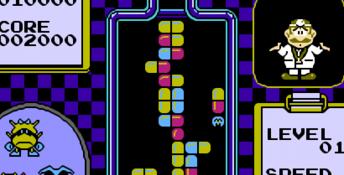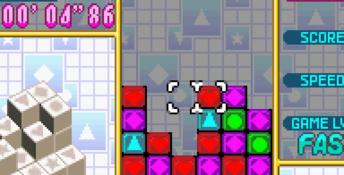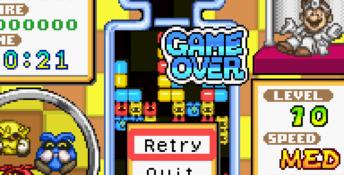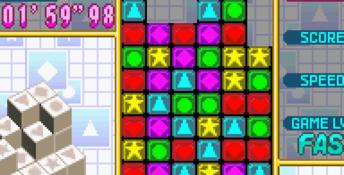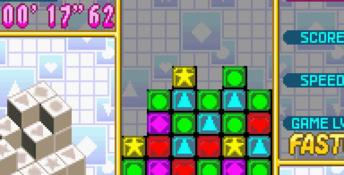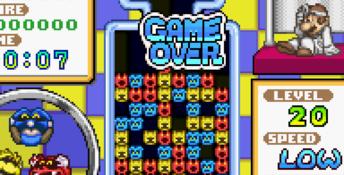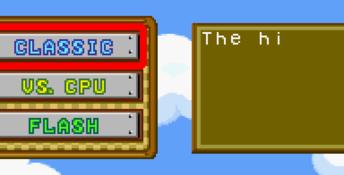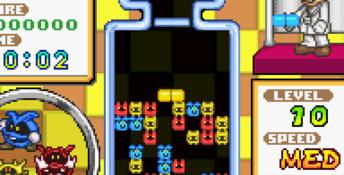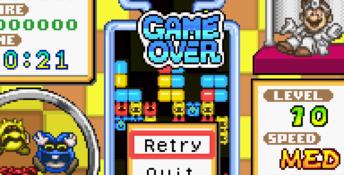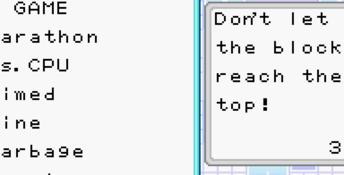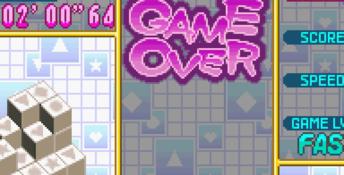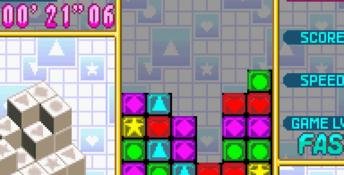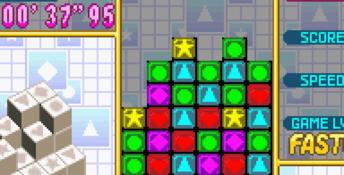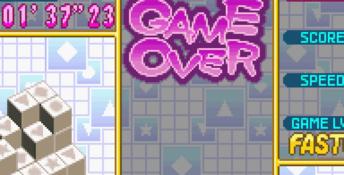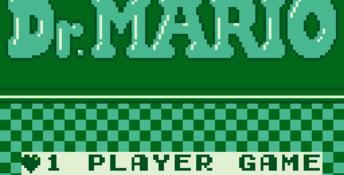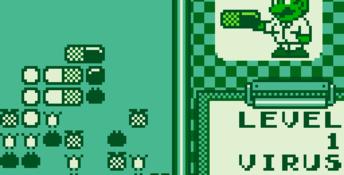Dr. Mario
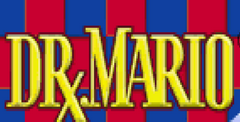
| a game by | Nintendo |
| Genres: | Puzzles & Words, Strategy/War |
| Platforms: |
GBA,
|
| Editor Rating: | 7.8/10, based on 8 reviews |
| User Rating: | 6.3/10 - 15 votes |
| Rate this game: | |
| See also: | High Score Games, Mario Games, Speedrun Games, Super Mario Games, Dr. Games |
- GameBoy - Nintendo
- Type: Puzzle
- Release: Nov.
- Levels: 20
- Difficulty: Avg.
The doctor is in! It seems that there are nasty viruses floating around at Nintendo and Mario has to destroy them with an overdose of vitamins. Like Columns, you drop capsules and each half could be either black, white or grey. Change the order of the colors as they fall. Match 4 halves either vertically or horizontally and they disappear. If they touch a virus of the same color it also will vanish.
People say:
Dr. Mario is good update to Tetris. By not allowing matches on the diagonal makes the game a bit shallow and flat but it still comes off well on the GameBoy. The puzzles start off easy but are challenging and fast paced in the higher levels.
Dr. Mario is Nintendo's attempt to clone Columns for the GameBoy (and soon the NES). Not only do you have to twirl "pills" into position a la Tetris, but you must also place them in rows to successfully eliminate the viruses. It's complicated in higher levels, but it is different.
Kids - Don't try to simulate this stunt yourself, these people are hardened professionals! Pop pills into formations that kill viruses. Spin the pills into the proper directions and then line them up to quickly eliminate buggers to advance. Tetris part #99.
Download Dr. Mario

System requirements:
- PC compatible
- Operating systems: Windows 10/Windows 8/Windows 7/2000/Vista/WinXP
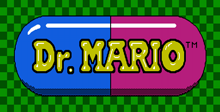
System requirements:
- PC compatible
- Operating systems: Windows 10/Windows 8/Windows 7/2000/Vista/WinXP
- P-200, 32 MB RAM

System requirements:
- PC compatible
- Operating systems: Windows 10/Windows 8/Windows 7/2000/Vista/WinXP
Game Reviews
Could it be Mario has settled down? After numerous adventures in the Mario Bros, series, he's turned in his running shoes for a stethoscope. Now he's a medical researcher at Mushroom Kingdom Hospital, experimenting in the virus lab.
But of course, Mario is a trouble magnet. Everywhere he goes, something is bound to happen that only quick reflexes and superhuman hand-eye coordination can fix. So one day, just as Mario was beginning work, Nurse Toadstool came rushing in with news that something had gone horribly wrong. One of the experimental viruses was growing out of control inside a laboratory bottle.
Fortunately, Mario had just developed a new set of vitamins that should have been able to kill the viruses. Unfortunately, things got complicated. The vitamins worked, but each one was effective only against a specific virus, and only when enough of the vitamins were used. In desperation, Mario began throwing vitamins into the laboratory bottle, trying to get enough of the right ones to the viruses they could kill.
A Tetris Clone?
Dr Mario is a fast-moving puzzle game that looks and plays a lot like Tetris. (It also bears some similarities to Columns, a new game for the Sega Genesis.) As Mario tosses the different-colored vitamin capsules into the laboratory bottle, they gradually fall from the top of the screen. Using the controller, you can steer the capsules left or right and rotate them to various positions. As in Tetris, your goal is to stack them up in just the right way.
The major difference is that instead of trying to eliminate horizontal layers, as you do in Tetris, your object in Dr. Mario is to eliminate the viruses that live in the jar. The viruses come in three strains: red, yellow, and blue. The capsules, you'll notice, also come in red, yellow, and blue. Most capsules are two of these colors, but some capsules are all the same color. The idea is to line up four or more pieces of the same color, either horizontally or vertically. By "pieces," we mean a whole capsule, or half of a capsule, or a virus. When that happens, all of the ma tching pieces disappear from the screen. If one or more of the pieces were viruses, you get points.
Play continues until either all the viruses are eliminated from the jar, or the jar gets so full of capsules that there's no room for another one. If you succeed in getting rid of all the viruses, you advance to the next level, which is even more contaminated with viruses. Although Dr. Mario (like Tetris) is basically a simple game, it's very difficult to master. The first few levels have only a few viruses, but pretty soon the jar gets so full of viruses that there's barely enough room for any vitamins.
Dr. Mario lets you choose from several options. You can select which level to start on (1 through 20); the speed at which Mario will toss in the vitamins (low, medium, or high); and even two different kinds of music ("Fever," "Chill," or no music at all). You can also select a two-player mode that lets you square off against another person. The main difference in a two-player game is that two jars fit side-by-side on the screen. Vitamin capsules are thrown into both jars simultaneously, and the goal is to eliminate your viruses before your opponent does. If you succeed in clearing out all of your viruses (or if your opponent allows his vitamins to pile up to the top of the bottle), you win the round. The first player to win three rounds wins the game.
Perhaps the best feature of the two-player mode is that each player can select his or her own level and speed. This provides two players of unequal skill with a good means of "handicapping."
If both players start at the same level, they'll begin each round with equal numbers of viruses in identical positions. Furthermore, Mario will toss the same color vitamins in the same order into each player's jar. This gives both players a totally equal chance of clearing the screen and completely eliminates luck as a factor. Two-player games are contests of pure skill.
Another feature that makes two-player games more competitive is that when you clear two or more lines simultaneously (whether or not they include viruses), some random, unconnected pieces of vitamin capsules will fall onto your opponent's screen. The number of pieces that fall is equal to the number of lines you cleared (up to four). Although their colors and positions are random, they always seem to fall in the places that are most annoying to your opponent. Therefore, it's possible to make life more difficult for your opponent, even though you can't affect his screen directly.
Strategy Tips
Dr. Mario is one of those games with simple rules that can be learned in a few minutes - but, like Tetris or Othello, it actually involves numerous, complex strategies. One key to shaping your strategy is to keep an eye on the upper right corner of the screen, where you can see the next vitamin Dr. Mario will toss into the jar. Although you can make the currently falling capsule fall faster by pushing down on the directional pad, you should probably just let it drop at its own pace. Use the time to look at what the next capsule will be, and figure out where it will fit.
It's also important to anticipate where broken pieces of capsules will drop. Each capsule consists of two halves, and if one half disappears when you match a row, the other half remains on the screen. When this happens, the half left behind drops until something stops it. If it happens to land somewhere to make another matching row of four colors, that row will also disappear, and any halves left behind will also drop, and so on.
It should be pretty obvious, therefore, that when you match a capsule to a row, you should also think about where the odd half will drop. How will the leftover piece affect the piles of capsules below it? The key to beating Dr. Mario - especially at the higher, more contaminated levels - is getting the knack of lining up capsules so that when one half disappears, the leftover half can drop somewhere useful.
If you drop a capsule on top of a different-colored virus, there are only three ways to clear the virus later. The first method is to simply pile on more capsules of the same wrong color until they form a matching row and disappear, leaving the virus uncovered. This method is the most common, and it works, but it also takes time. In addition, the halves left behind might cover other viruses in the process, so careful planning is essential.
The second way to clear a virus that's buried beneath wrong-colored capsules is to match it with a horizontal row of pieces. This is probably better than method #1, but isn't always possible. Again, careful planning is the only way to keep those lines clear.
The third method is even more difficult - form a vertical stack by building up matching capsules beneath the virus. This is possible because viruses, unlike capsules, do not fall toward the bottom of the screen when there's nothing to support them. They hang in midair, and sometimes you can slide capsules into place underneath.
Like other Tefns-style games, Dr. Mario is an exercise in thinking ahead under pressure. You can usually recover from mistakes, but it always takes time. And the longer you take to clear a level, the faster Dr. Mario tosses in the capsules.
Unlike other Tetris variants, however, Dr. Mario has viruses, and you can see them magnified in the lower left corner of the screen. When the jar fills up and you've lost, they'll laugh at you, too. Ever hear a virus laugh?
Tetris fever has invaded the NES. Nintendo has come up with yet another clone, this time trying to lure players to this game by including the popular Mario name. In this version your goal is to destroy viruses by dropping and rotating multicolored pills. Play either by yourself or select the two player mode and compete with a friend. Adjust the difficulty by selecting the speed at which the pills drop in the bottle and choose the level at which you wish to start.
An epidemic has been spreading through the world of electronic gaming over the past couple of years. Like most epidemics it started quietly, but soon raged out of control. It originated in a foreign country, then marched through Europe, North America, and most of the rest of the world.
It first hit the United States in 1988 in the form of a simple but endlessly challenging puzzle game for PC-compatible computers. From there it spread like wildfire to arcades and home videogame systems, conquering millions of game players along the way. What's the name of this "epidemic"? Tetris, of course. But while many players have broken the initial grip of Tetris fever, it has spread to videogame designers eager to capitalize on the success of Tetris. Several companies have released games that try to imitate the magical combination of simple design and engrossing game play that gives Tetris such broad appeal.
Now it's Nintendo's turn. And to sweeten the pot a bit, Nintendo's entry in "the next Tetris" race also stars everyone's favorite plumber — or should we say doctor?
Dr Mario may conjure up images of adventures in the Mushroom Kingdom, but you won't find any pipes, coins, warp zones, or secret rooms here. What you can expect is a simple, highly addictive, and compulsively playable little mind-bender. Nintendo has simultaneously released versions of Dr. Mario for the NES and Game Boy, and the Game Boy version is practically identical to its big-screen brother. (For a look at the NES version of Dr. Mario, check out the "Nintendo News" column elsewhere in this issue.)
Mario has traded in his plumber's garb for a stethoscope and lab coat, but even in the sterile environment of a hospital he can't seem to stay out of trouble. One of his virus experiments has gone haywire, and the little critters are spreading quickly. It's lucky for Mario that he's developed vitamins that can eliminate the viruses on contact.
When the game begins, the screen shows a jar containing several runaway viruses. There are three kinds of viruses — black, white, and gray. You have six kinds of vitamin capsules to use against the viruses, each made up of two colors. A capsule can be all black, all white, all gray, or a combination of two of those three colors.
Dr. Mario stands in the upper right corner of the screen, tossing vitamin capsules into the jar, one by one. As a capsule descends, you can move it left or right with the directional pad. You can also rotate the capsule in either direction with the A and B buttons, and make it drop faster by pressing down on the directional pad.
Your goal in Dr. Mario is to eliminate all the viruses from the jar. Whenever you form a row of four matching colors, that row disappears, including any viruses in the row. If only half of a capsule was used in the row, the other half drops until it lands on a virus, another capsule, or the bottom of the jar. You earn points only if your matching row contains a virus.
You can start the game on 20 different levels. Level 1 has only four viruses in the jar, and even a beginning player can quickly eliminate them. But once you've cleared the biological baddies from one jar, you advance to the next one. Each jar (level) contains four more viruses than the previous jar. This continues (if you're successful) until the 20th level, where you're faced with 84 viruses crammed in until they almost reach the top of the bottle. Just the sight of that many viruses on a Game Boy screen is unnerving.
The idea of a puzzle game in which you form rows of matching colors isn't new, of course. Similar games include Sega of America's Columns for the Genesis and Tengen's Klax for the NES, Genesis, NECTurboGrafx-16, and Atari Lynx. Klax, however, sends only one color down the screen at a time, and Columns drops blocks of three interchangeable colors.
Because you can rotate the colored capsules as they fall, Dr. Mario is basically a mix of Columns, Klax, and — you guessed it — Tetris. It's the rotation feature that adds more strategy to the game. If you plan ahead, you can place a vitamin capsule so that half is part of a match, causing the other half to fall and help complete another match. Mastering this domino effect is one of the keys to success in Dr. Mario.
Although it's easier to create vertical rows of matching colors, the fastest way to eliminate viruses that have been "buried" beneath capsules is to match them with a horizontal row. Time is definitely a factor, though, because the game speeds up after every tenth capsule is thrown into the jar.
To plan your next move, keep an eye on Dr. Mario. Right after he tosses a vitamin capsule into the bottle, the next capsule he will toss appears in his hand. He won't toss it until the first capsule lands, so (at first, anyway) don't make the vitamins drop faster by pressing down on the directional pad. That way you'll have plenty of time to figure out the best place for the next capsule to land. The only exception to this strategy is when you're competing head-to-head against another player. In a two-player game, speed is very important.
The two-player mode requires two Game Boys (each with a Dr. Mario cartridge) hooked together with the Video Link cable. Each player's screen has an identical vitamin bottle, and the capsules drop in the same order for both players. It's basically a race to see who can eliminate all the viruses first, but there's a slight twist. If you eliminate two or more rows with a single capsule, random pieces of capsules will fall into your opponent's bottle — usually in the most inconvenient places. A random piece falls for every row you clear, up to four rows. In other words, if you clear two rows, two random pieces will fall into your opponent's jar; if you clear four (or more) rows, then four pieces will fall.
If your opponent's jar gets filled to the top, you win the round, even if you still have viruses remaining in your bottle. The first player to win three rounds wins the game. You can set the speed and the number of viruses differently for each player, so a less-experienced player can compete on an even basis against a more skilled player.
Dr. Mario has two soundtracks to choose from, appropriately named "Fever" and "Chill." (There's also an option for no music.) "Fever" is a rolling, fast-paced boogie number, while "Chill" is much slower and more workmanlike. After playing the game for some time, I got the impression that the faster music worked best at the lower levels, while the frantic pace of the upper levels could be slightly neutralized by the slower music.
Puzzle games have always translated well to the Game Boy, and Dr. Mario is no exception. It loses none of its playability due to the smaller screen. In fact, the two-player mode might be even easier on the Game Boy than on the NES — the NES version squeezes both players' bottles onto the same screen. Combine that with the temptation to look at your opponent's bottle, and you can find yourself making mistakes you wouldn't make in a one-player game.
Nintendo has borrowed the best qualities from several puzzle games and rolled them into a nice package in Dr. Mario. It's simple to learn, difficult to master, and very tough to quit playing, even if you've been stuck on the same level for many hours. True, the game's title is a bit misleading, since Mario doesn't really play much of a role — some people might be expecting another hopping-and-bopping adventure. But if you like a good challenge and don't mind a little frustration, Dr. Mario is the perfect prescription for your Game Boy.
- Manufacturer: Nintendo
- Version: NES
Kristi Smith of Westminister, California, was the first to send in this Easter egg. Kristi found that if you wait long enough on the intermission screen (where the three viruses are sitting on the tree), an item will fly across the top of the screen. It only works with certain virus level/speed combinations.
- Machine: Game Boy
An epidemic has been spreading through the world of electronic gaming over the past couple of years. Like most epidemics it started quietly, but soon raged out of control. It originated in a foreign country, then marched through Europe, North America, and most of the rest of the world.
It first hit the United States in 1988 in the form of a simple but endlessly challenging puzzle game for PC-compatible computers. From there it spread like wildfire to arcades and home videogame systems, conquering millions of game players along the way.
What's the name of this "epidemic"? Tetris, of course. But while many players have broken the initial grip of Tetris fever, it has spread to videogame designers eager to capitalize on the success of Tetris. Several companies have released games that try to imitate the magical combination of simple design and engrossing game play that gives Tetris such broad appeal.
Now it's Nintendo's turn. And to sweeten the pot a bit, Nintendo's entry in "the next Tetris" race also stars everyone's favorite plumber - or should we say doctor?
Dr Mario may conjure up images of adventures in the Mushroom Kingdom, but you won't find any pipes, coins, warp zones, or secret rooms here. What you can expect is a simple, highly addictive, and compulsively playable little mind-bender. Nintendo has simultaneously released versions of Dr. Mario for the NES and Game Boy, and the Game Boy version is practically identical to its big-screen brother. For a look at the NES version of Dr. Mario, check out the "Nintendo News" column elsewhere in this issue.
Mario has traded in his plumber's garb for a stethoscope and lab coat, but even in the sterile environment of a hospital he can't seem to stay out of trouble. One of his virus experiments has gone haywire, and the little critters are spreading quickly. It's lucky for Mario that he's developed vitamins that can eliminate the viruses on contact.
When the game begins, the screen shows a jar containing several runaway viruses. There are three kinds of viruses - black, white, and gray. You have six kinds of vitamin capsules to use against the viruses, each made up of two colors. A capsule can be all black, all white, all gray, or a combination of two of those three colors.
Dr. Mario stands in the upper right comer of the screen, tossing vitamin capsules into the jar, one by one. As a capsule descends, you can move it left or right with the directional pad. You can also rotate the capsule in either direction with the A and B buttons, and make it drop faster by pressing down on the directional pad.
Your goal in Dr. Mario is to eliminate all the viruses from the jar. Whenever you form a row of four matching colors, that row disappears, including any viruses in the row. If only half of a capsule was used in the row, the other half drops until it lands on a virus, another capsule, or the bottom of the jar. You earn points only if your matching row contains a virus.
You can start the game on 20 different levels. Level 1 has only four viruses in the jar, and even a beginning player can quickly eliminate them. But once you've cleared the biological baddies from one jar, you advance to the next one. Each jar (level) contains four more viruses than the previous jar. This continues (if you're successful) until the 20th level, where you're faced with 84 viruses crammed in until they almost reach the top of the bottle. Just the sight of that many viruses on a Game Boy screen is unnerving.
The idea of a puzzle game in which you form rows of matching colors isn't new, of course. Similar games include Sega of America's Columns for the Genesis and Tengen's Klax for the NES, Genesis, NEC TurboGrafx-16, and Atari Lynx. Klax, however, sends only one color down the screen at a time, and Columns drops blocks of three interchangeable colors.
Because you can rotate the colored capsules as they fall, Dr. Mario is basically a mix of Columns, Klax, and - you guessed it - Tetris. It's the rotation feature that adds more strategy to the game. If you plan ahead, you can place a vitamin capsule so that half is part of a match, causing the other half to fall and help complete another match. Mastering this domino effect is one of the keys to success in Dr. Mario.
Although it's easier to create vertical rows of matching colors, the fastest way to eliminate viruses that have been "buried" beneath capsules is to match them with a horizontal row. Time is definitely a factor, though, because the game speeds up after every tenth capsule is thrown into the jar.
To plan your next move, keep an eye on Dr. Mario. Right after he tosses a vitamin capsule into the bottle, the next capsule he will toss appears in his hand. He won't toss it until the first capsule lands, so (at first, anyway) don't make the vitamins drop faster by pressing down on the directional pad. That way you'll have plenty of time to figure out the best place for the next capsule to land.
The only exception to this strategy is when you're competing head-to-head against another player. In a two-player game, speed is very important.
The two-player mode requires two Game Boys (each with a Dr. Mario cartridge) hooked together with the Video Link cable. Each player's screen has an identical vitamin bottle, and the capsules drop in the same order for both players. It's basically a race to see who can eliminate all the viruses first, but there's a slight twist. If you eliminate two or more rows with a single capsule, random pieces of capsules will fall into your opponent's bottle - usually in the most inconvenient places. A random piece falls for every row you clear, up to four rows. In other words, if you clear two rows, two random pieces will fall into your opponent's jar; if you clear four (or more) rows, then four pieces will fall.
If your opponent's jar gets filled to the top, you win the round, even if you still have viruses remaining in your bottle. The first player to win three rounds wins the game. You can set the speed and the number of viruses differently for each player, so a less-experienced player can compete on an even basis against a more skilled player.
Dr. Mario has two soundtracks to choose from, appropriately named "Fever" and "Chill". There's also an option for no music. "Fever" is a rolling, fast-paced boogie number, while "Chill" is much slower and more workmanlike. After playing the game for some time, I got the impression that the faster music worked best at the lower levels, while the frantic pace of the upper levels could be slightly neutralized by the slower music.
Puzzle games have always translated well to the Game Boy, and Dr. Mario is no exception. It loses none of its playability due to the smaller screen. In fact, the two-player mode might be even easier on the Game Boy than on the NES - the NES version squeezes both players' bottles onto the same screen. Combine that with the temptation to look at your opponent's bottle, and you can find yourself making mistakes you wouldn't make in a one-player game.
Nintendo has borrowed the best qualities from several puzzle games and rolled them into a nice package in Dr. Mario. It's simple to learn, difficult to master, and very tough to quit playing, even if you've been stuck on the same level for many hours. True, the game's title is a bit misleading, since Mario doesn't really play much of a role - some people might be expecting another hopping-and-bopping adventure. But if you like a good challenge and don't mind a little frustration, Dr. Mario is the perfect prescription for your Game Boy.
- Nintendo
Could it be Mario has settled down? After numerous adventures in the Mario Bros, series, he's turned in his running shoes for a stethoscope. Now he's a medical researcher at Mushroom Kingdom Hospital, experimenting in the virus lab.
But of course, Mario is a trouble magnet. Everywhere he goes, something is bound to happen that only quick reflexes and superhuman hand-eye coordination can fix. So one day, just as Mario was beginning work, Nurse Toadstool came rushing in with news that something had gone horribly wrong. One of the experimental viruses was growing out of control inside a laboratory bottle.
Fortunately, Mario had just developed a new set of vitamins that should have been able to kill the viruses. Unfortunately, things got complicated. The vitamins worked, but each one was effective only against a specific virus, and only when enough of the vitamins were used. In desperation, Mario began throwing vitamins into the laboratory bottle, trying to get enough of the right ones to the viruses they could kill.
A Tetris Clone?
Dr Mario is a fast-moving puzzle game that looks and plays a lot like Tetris. It also bears some similarities to Columns, a new game for the Sega Genesis. As Mario tosses the different-colored vitamin capsules into the laboratory bottle, they gradually fall from the top of the screen. Using the controller, you can steer the capsules left or right and rotate them to various positions. As in Tetris, your goal is to stack them up in just the right way.
The major difference is that instead of trying to eliminate horizontal layers, as you do in Tetris, your object in Dr. Mario is to eliminate the viruses that live in the jar. The viruses come in three strains: red, yellow, and blue. The capsules, you'll notice, also come in red, yellow, and blue. Most capsules are two of these colors, but some capsules are all the same color.
The idea is to line up four or more pieces of the same color, either horizontally or vertically. By "pieces", we mean a whole capsule, or half of a capsule, or a virus. When that happens, all of the matching pieces disappear from the screen. If one or more of the pieces were viruses, you get points.
Play continues until either all the viruses are eliminated from the jar, or the jar gets so full of capsules that there's no room for another one. If you succeed in getting rid of all the viruses, you advance to the next level, which is even more contaminated with viruses.
Although Dr. Mario (like Tetris) is basically a simple game, it's very difficult to master. The first few levels have only a few viruses, but pretty soon the jar gets so full of viruses that there's barely enough room for any vitamins.
Dr. Mario lets you choose from several options. You can select which level to start on (1 through 20); the speed at which Mario will toss in the vitamins (low, medium, or high); and even two different kinds of music ("Fever", "Chill", or no music at all).
You can also select a two-player mode that lets you square off against another person. The main difference in a two-player game is that two jars fit side-by-side on the screen. Vitamin capsules are thrown into both jars simultaneously, and the goal is to eliminate your viruses before your opponent does. If you succeed in clearing out all of your viruses (or if your opponent allows his vitamins to pile up to the top of the bottle), you win the round. The first player to win three rounds wins the game.
Perhaps the best feature of the two-player mode is that each player can select his or her own level and speed. This provides two players of unequal skill with a good means of "handicapping".
If both players start at the same level, they'll begin each round with equal numbers of viruses in identical positions. Furthermore, Mario will toss the same color vitamins in the same order into each player's jar. This gives both players a totally equal chance of clearing the screen and completely eliminates luck as a factor. Two-player games are contests of pure skill.
Another feature that makes two-player games more competitive is that when you clear two or more lines simultaneously (whether or not they include viruses), some random, unconnected pieces of vitamin capsules will fall onto your opponent's screen. The number of pieces that fall is equal to the number of lines you cleared (up to four). Although their colors and positions are random, they always seem to fall in the places that are most annoying to your opponent. Therefore, it's possible to make life more difficult for your opponent, even though you can't affect his screen directly.
Strategy Tips
Dr. Mario is one of those games with simple rules that can be learned in a few minutes - but, like Tetris or Othello, it actually involves numerous, complex strategies.
One key to shaping your strategy is to keep an eye on the upper right corner of the screen, where you can see the next vitamin Dr. Mario will toss into the jar. Although you can make the currently falling capsule fall faster by pushing down on the directional pad, you should probably just let it drop at its own pace. Use the time to look at what the next capsule will be, and figure out where it will fit.
It's also important to anticipate where broken pieces of capsules will drop. Each capsule consists of two halves, and if one half disappears when you match a row, the other half remains on the screen. When this happens, the half left behind drops until something stops it. If it happens to land somewhere to make another matching row of four colors, that row will also disappear, and any halves left behind will also drop, and so on.
It should be pretty obvious, therefore, that when you match a capsule to a row, you should also think about where the odd half will drop. How will the leftover piece affect the piles of capsules below it? The key to beating Dr. Mario - especially at the higher, more contaminated levels - is getting the knack of lining up capsules so that when one half disappears, the leftover half can drop somewhere useful.
If you drop a capsule on top of a different-colored virus, there are only three ways to clear the virus later. The first method is to simply pile on more capsules of the same wrong color until they form a matching row and disappear, leaving the virus uncovered. This method is the most common, and it works, but it also takes time. In addition, the halves left behind might cover other viruses in the process, so careful planning is essential.
The second way to clear a virus that's buried beneath wrong-colored capsules is to match it with a horizontal row of pieces. This is probably better than method #1, but isn't always possible. Again, careful planning is the only way to keep those lines clear.
The third method is even more difficult - form a vertical stack by building up matching capsules beneath the virus. This is possible because viruses, unlike capsules, do not fall toward the bottom of the screen when there's nothing to support them. They hang in midair, and sometimes you can slide capsules into place underneath.
Like other Tetris-style games, Dr. Mario is an exercise in thinking ahead under pressure. You can usually recover from mistakes, but it always takes time. And the longer you take to clear a level, the faster Dr. Mario tosses in the capsules.
Unlike other Tetris variants, however, Dr. Mario has viruses, and you can see them magnified in the lower left corner of the screen. When the jar fills up and you've lost, they'll laugh at you, too. Ever hear a virus laugh?
- Machine: GameBoy
- Number of Levels: 20
- Theme: Puzzle/Reflex
- Difficulty: Average
- Number of Players: 1 or 2
- Available: November '90
Calling Dr Mario...
It looks like Mario got tired of sitting around waiting for his fourth adventure to start and he must have gone back to school! He now is a full fledged M.D. and his newest challenge is to kill off some very nasty viruses floating around Nintendo's headquarters.
Your main weapons are vitamin capsules, each half of which could be either black, white or grey. Your job is to line up the vitamins in such a way that at least four halves of the capsules are the same color either horizontally or vertically. Do this and the capsules disappear along with any of the nasty viruses which happen to be in contact with, and the same color as, the matched capsules. Eliminate all the virus vermin on the screen and you get to progress to tne next level.
Dr Mario plays very much like a cross between Tetris and Sega's Columns, as you can rotate the capsules like in Tetris and make matches of similar colors as in Columns. Unlike Columns though, you can't match up capsules diagonally. You can select your starting level; the type of background music; the game play speed and the number of players.
